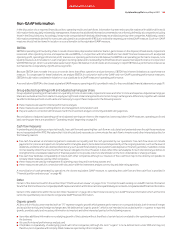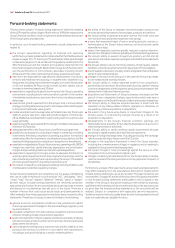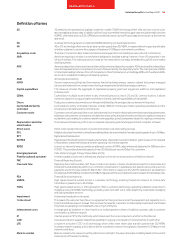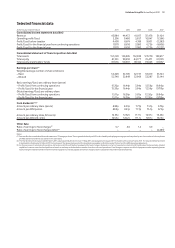Vodafone 2011 Annual Report Download - page 152
Download and view the complete annual report
Please find page 152 of the 2011 Vodafone annual report below. You can navigate through the pages in the report by either clicking on the pages listed below, or by using the keyword search tool below to find specific information within the annual report.150 Vodafone Group Plc Annual Report 2011
Mobile broadband Also known as mobile internet (see below).
Mobile customer A mobile customer is defined as a subscriber identity module (‘SIM’), or in territories where SIMs do not exist, a
unique mobile telephone number, which has access to the network for any purpose, including data only usage,
except telemetric applications. Telemetric applications include, but are not limited to, asset and equipment tracking,
mobile payment and billing functionality, e.g. vending machines and meter readings, and include voice enabled
customers whose usage is limited to a central service operation, e.g. emergency response applications in vehicles.
Mobile internet Browser based access to the internet or web applications using a mobile device, such as a smartphone, connected
to a wireless network.
Mobile termination rate (‘MTR’) A per minute charge paid by a telecommunications network operator when a customer makes a call to another
mobile or fixed line network operator.
MVNO Mobile virtual network operators, companies that provide mobile phone services but do not have their own licence
of spectrum or the infrastructure required to operate a network.
Net debt Long-term borrowings, short-term borrowings and mark-to-market adjustments on financing instruments less cash
and cash equivalents.
Net promoter score Net promoter score (‘NPS’) is a customer loyalty metric used to monitor customer satisfaction.
Operating costs Operating expenses plus customer costs other than acquisition and retention costs.
Operating expenses Operating expenses comprise primarily of network and IT related expenditure, support costs from HR and finance
and certain intercompany items.
Operating free cash flow Cash generated from operations after cash payments for capital expenditure (excludes capital licence and spectrum
payments) and cash receipts from the disposal of intangible assets and property, plant and equipment.
Organic growth The percentage movements in organic growth are presented to reflect operating performance on a comparable
basis, both in terms of merger and acquisition activity and foreign exchange rates.
Partner markets Markets in which the Group has entered into a partner agreement with a local mobile operator enabling a range of
Vodafone’s global products and services to be marketed in that operator’s territory and extending Vodafone’s reach
into such markets.
Penetration Number of SIMs in a country as a percentage of the country’s population. Penetration can be in excess of 100% due
to customers’ owning more than one SIM.
Petabyte A petabyte is a measure of data usage. One petabyte is a million gigabytes.
Pps Percentage points.
Pro-forma growth Pro-forma growth is organic growth adjusted to include acquired business for the whole of both periods.
Reported growth Reported growth is based on amounts reported in pounds sterling as determined under IFRS.
RAN Radio access network is part of a mobile telecommunication system which conceptually sits between the mobile
phone and the base station.
Retention costs The total of trade commissions, loyalty scheme and equipment costs relating to customer retention and upgrade.
Roaming Allows our customers to make calls on other operators’ mobile networks while travelling abroad.
Service revenue Service revenue comprises all revenue related to the provision of ongoing services including, but not limited to,
monthly access charges, airtime usage, roaming, incoming and outgoing network usage by non-Vodafone
customers and interconnect charges for incoming calls.
Smartphone devices A smartphone is a mobile phone offering advanced capabilities including access to email and the internet.
Smartphone penetration The number of smartphone devices divided by the number of registered SIMs, excluding data only SIMs.
Spectrum The radio frequency bands and channels assigned for telecommunication services.
Tablet device A tablet is a slate shaped, mobile or portable, casual computing device equipped with a finger operated touchscreen
or stylus, for example, the Apple iPad.
Visitor revenue Amounts received by a Vodafone operating company when customers of another operator, including those of other
Vodafone companies, roam onto its network.
Wi-Fi A Wi-Fi enabled device such as a smartphone can connect to the internet when within a range of a wireless network
connected to the internet.
Denition of terms continued


















